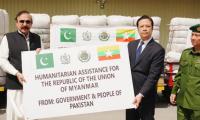The message for the world from the recent COP26 meeting in Glasgow is clear – we must reduce greenhouse gas (GHG) emissions and one of the biggest sources is energy. But how do we balance the growing need for energy across Asia and the Pacific, with the imperative to reduce GHGs?
Recent spikes in energy prices—felt acutely in our region—are the latest reminder that past and current ways of production and consumption are unsustainable. However, despite considerable progress on energy access in recent years, 940 million people in our region still experience frequent interruptions, around 350 million remain without adequate supply while some 150 million have no access to electricity.
Now is the time for bold action and a future powered by diverse, renewable energy sources will be more equitable and prosperous for all. ADB’s new policy announced last month, maps five main pathways to help our developing member countries transition to a brighter energy future.
The first, and among the most critical, is to continue electrifying underserved areas throughout the region to meet at least basic energy needs—a key step in eradicating extreme poverty and creating more equitable societies. Cleaner approaches to everyday living—lighting, cooking, heating, and cooling—will add up as their adoption spreads from household to household. ADB will promote a cleaner and more broadly accessible electric grid while also advocating for greater social inclusion and gender equality along the way.
Second, our updated policy reflects the unescapable truth that tackling climate change is the critical issue of our times. Every year our region is hit with extreme weather, with increasingly catastrophic and deadly effects. Agriculture, which many in the region depend on for their livelihoods, is threatened by floods and droughts. If global temperature increases are not constrained, parts of Asia and the Pacific may even become uninhabitable by humans due to extreme heat stress or saltwater inundation caused by sea level rises and storm surges. The culprit is greenhouse gas emissions and many of those come from energy.
To foster change, ADB will help its member countries improve energy efficiency, use more renewable and low-carbon energy, and integrate climate and disaster resilience into their energy sectors.
This means in Pakistan for example, we’ll continue to support the construction of the Balakot Hydropower project, which is expected to add more than 1,100 gigawatt-hours of clean energy per year and reduce Pakistan’s dependence on fossil fuels. In the Pacific, we’ve ramped up preparations under an innovative renewable energy investment facility to deploy climate-adaptive floating solar technology and significantly expand access to sustainable power in 11 small Pacific Island countries.
And in Indonesia and the Philippines, our new energy policy provides a platform to phase out coal on an unprecedented scale. At COP26, we joined with those countries to launch the Southeast Asia Partnership for the Energy Transition Mechanism (ETM), which will incentivize the early retirement of coal-fired power plants and position Indonesia and the Philippines as pioneers in the low-carbon transition. Retiring half the coal fleet in those countries and in Viet Nam could potentially cut 200 million tons of carbon dioxide emissions per year – the equivalent of taking 61 million cars off the road. It would make ETM one of the biggest carbon reduction programs in the world.
In addition to phasing out existing coal facilities, we have also formalized our practice of not financing new coal-fired power and heating plants. While one policy cannot fit all countries, we will remain steadfast in our use of more sustainable energy sources while working to ease the impact of change on affected workers and communities.
Third, smart energy policy also means smart governance. ADB will help create the strong frameworks needed as the sector moves away from a traditional, more centralized environment. That means we’ll serve as a knowledge hub to provide country-specific technical support while broadly sharing best emerging practices, innovations, and green technologies. We will also continue to advocate for the good governance of institutions and companies within the sector.
Fourth, just as environmental impacts transcend political boundaries, ADB will work to embrace and promote more regional cooperation and integration in the energy sector too. The impact of innovative ideas and strategies can be greatly magnified when shared from country to country. So can investment strategies that embrace a broader electricity network infrastructure, as well as the building of regional energy markets. This should result in lower costs, reduced greenhouse emissions, and an energy grid made more secure thanks to its diversity.
Finally, we’ll continue to invest in green bonds, use a range of financing mechanisms, and align our lending with progressive policies across all aspects of our work, with the overarching goal of a more sustainable future always at the forefront. We’ll work hard to make more concessional financing available and stimulate private sector investment to back our members’ ambitions.
Our updated policy builds on our demonstrated commitment to the energy sector, with more than $42 billion in financing contributed over the past decade. But neither we nor any one actor can shape a more resilient future alone—and commercial financing will be critical to success. Recently, we have raised our ambition to deliver $100 billion in total climate financing from our own resources in 2019-2030, up $20 billion from a commitment made just three years ago. And, of ADB’s total projects, at least 75% will feature climate adaptation and mitigation initiatives.
Too often in the past, the laudable goal of expanding energy systems came at the expense of our environment. We can and must do more to secure energy access while placing sustainability at the center of our efforts. Our new energy policy will help to promote an inclusive, equitable Asia and the Pacific while helping nurture and rebuild the fragile, imperiled natural world we share.
The writers are senior officials at the Asian Development Bank
Honda officials posing for a photgraph. —APP/FileKARACHI: Honda Atlas Cars Pakistan Ltd has achieved a major...
SOS children village's children showing bags donated by Emirates International Airlines. — Emirates...
Automobiles at the shipping terminal are shown from the view of a drone in San Diego, California, US, March 26, 2025....
Key challenge lies in whether the ruling elite is willing to implement changes that could weaken their grip on power
A woman holds a smartphone displaying the logo of social network X . — AFP/FileElon Musk said his xAI artificial...
A representational image of a person using his cellphone for a digital transaction. — Unsplash/FileKARACHI: Chief...







